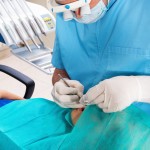
Fibrous hyperplasia can be found in any part of the mouth and are thought to affect between 5-16% of the population. They commonly present as small painless lesions and are frequently the result of trauma from an ill fitting denture. Traditionally they are removed with a scalpel but with the increasing use of surgical lasers for oral lesions. The aim of this study was to compare the effects of diode laser surgery with conventional techniques using scalpels.
Methods
Consecutive oral medicine patients presenting with fibrous hyperplasia caused either by dentures or by parafunctional habits were randomised to either conventional surgical removal (control) or 808nm diode laser removal (test). The same local anesthetic agent (2% lidocaine and adrenaline at 1:100,000) was used for both group but the test group also received topical anaesthesia. While suturing was used to close the wound in the control group, no suturing was undertaken in the test group. Paracetamol was prescribed for postoperative pain relief.
The following parameters were measured: type of anaesthesia; duration of surgery; oedema; secondary infection; postoperative pain; analgesic use; postoperative functional alterations, i.e., alterations in eating and speech; clinical healing, and patient satisfaction.
Results
- 36 patients were randomised. 34 patients were included in the analysis.
- The fibrous hyperplasia was caused by dentures in 26 of the patients (76.5%)
- The duration of surgery was shorter in the study group, but these patients reported more oedema. More analgesic medicine was consumed by patients in the control group, but the time to clinical healing of the postoperative wounds was shorter in this group. These differences were statistically significant.
- No secondary infection was observed in either group, and all patients in both groups reported total satisfaction with the treatment.
| Test | Control | |
| Number of patients | 17 | 17 |
| Surgery duration, min (mean ± SD) | 5.4 ±3.6 | 7.8 ± 3.2 |
| Analgesic usage, n (%) | 6 (35%) | 13 (76%) |
| Oedema | 12 (71%) | 6 (35%) |
| Clinical healing of the postoperative wound, days (mean ±SD) | 24.29 ± 4.37 | 21.41 ± 1.69 |
Conclusions
The authors concluded:
..diode laser surgery proved to be effective in the management of fibrous hyperplasia, decreasing the duration of surgery and the need for analgesic medication, minimizing bleeding, and eliminating the need for sutures. Furthermore, patients tended to tolerate this procedure quite well. Thus, diode laser surgery demonstrated less invasiveness when compared to scalpel surgery. By contrast, wound healing proved to be faster with scalpel surgery when compared to diode laser surgery.
Comments
This small study suggests that that while diode laser treatment was marginally quicker and required fewer analgesics and no sutures there was more swelling and wound healing was longer. In terms of assessing the wound healing, it is not clear whether this was undertaken by operator and owing to the different wound characteristics. It would have been difficult to blind an observer particularly during the early stages of healing, so the possibility of bias presents a fact noted by the authors. Additional studies are needed to confirm these findings.
Links
Amaral MB, de Ávila JM, Abreu MH, Mesquita RA. Diode laser surgery versus scalpel surgery in the treatment of fibrous hyperplasia: a randomized clinical trial. Int J Oral Maxillofac Surg. 2015 Jul 17. pii: S0901-5027(15)00206-4. doi: 10.1016/j.ijom.2015.05.015. [Epub ahead of print] PubMed PMID: 26194769.

Diode laser or scalpel surgery for fibrous hyperplasia? http://t.co/AYbmxt6bb7
Shorter treatment for fibrous hyperplasia with diode laser http://t.co/AYbmxt6bb7
Scalpel or diode laser surgery for fibrous hyperplasia? http://t.co/AYbmxt6bb7
Diode laser surgery for fibrous hyperplasia less painful? http://t.co/AYbmxt6bb7
Don’t miss- Diode laser or scalpel surgery for fibrous hyperplasia? http://t.co/AYbmxt6bb7
Diode laser for fibrous hyperplasia – faster but more swelling and longer healing http://t.co/YaCsIKO0ow #UTORlibs